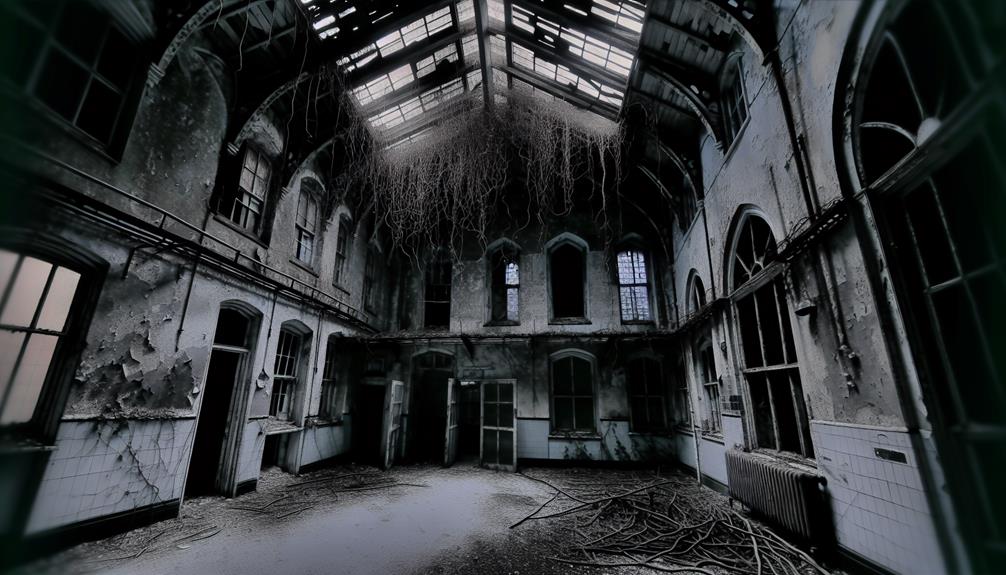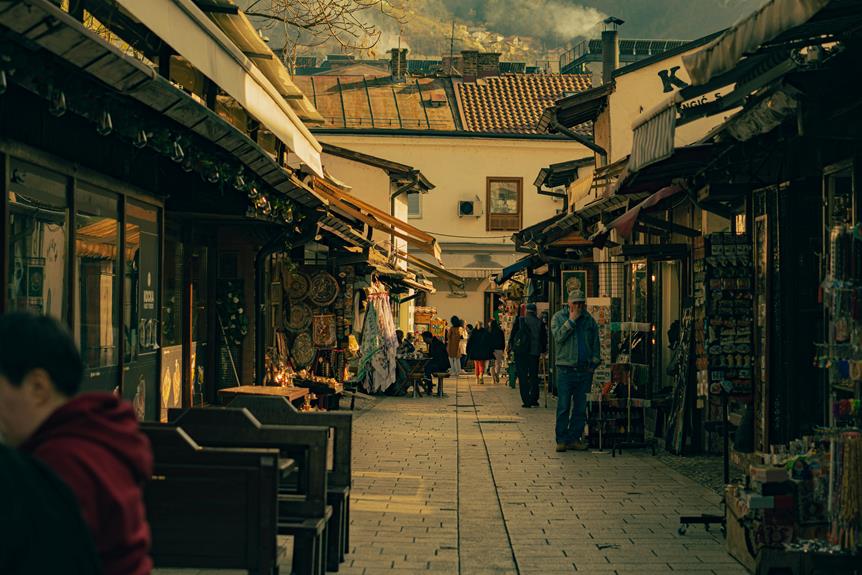The eruption of Krakatoa in 1883 stands as a proof of nature's raw power, altering landscapes and livelihoods in its wake. However, beyond the immediate chaos lies a tale of resilience and adaptation that continues to unfold. As we explore the legacy of Krakatoa, we uncover a narrative of destruction intertwined with the intriguing story of rebirth and recovery. The journey through this cataclysmic event offers not just a glimpse into the past but also valuable insights into the intricate workings of our planet.
Key Takeaways
- Krakatoa eruption in 1883 reshaped the landscape.
- Ecological changes led to new habitats and extinctions.
- Cultural preservation vital for local heritage.
- Environmental shifts studied for ecosystem insights.
- Resilience shown in community participation and preservation efforts.
The Eruption of Krakatoa
The cataclysmic eruption of Krakatoa in 1883, located in the Sunda Strait of Indonesia, stands as one of the most powerful volcanic events in recorded history. This natural disaster released a series of violent explosions that culminated in the obliteration of the island itself. The eruption began on August 26, 1883, with a series of eruptions so intense that they were heard thousands of kilometers away. The explosions were so powerful that they ruptured eardrums of sailors in the surrounding areas and generated pressure waves that reverberated around the globe seven times.
The volcanic destruction caused by Krakatoa's eruption was unprecedented. The island was devastated, with over two-thirds of its landmass disintegrated and submerged underwater. The explosions and tsunamis resulting from the eruption claimed the lives of over 36,000 people, making it one of the deadliest volcanic events in history. The impact of the eruption was felt far beyond the immediate vicinity, with ash and aerosols ejected into the atmosphere causing dramatic sunsets worldwide.
Krakatoa's eruption serves as a stark reminder of the immense power and destructive potential of volcanic activity. It stands as a demonstration of the raw forces of nature and the catastrophic consequences that can arise from such events. This natural disaster left a lasting impact on the region and the world, reshaping landscapes and livelihoods in its wake.
Impact on Global Climate
How did Krakatoa's eruption impact the global climate?
The eruption of Krakatoa in 1883 had significant impacts on the global climate, causing widespread atmospheric effects that led to short-term cooling and long-term climate changes. The eruption released massive amounts of ash, sulfur dioxide, and other gases into the atmosphere, which had far-reaching consequences.
The sulfur dioxide emitted during the eruption combined with water vapor in the atmosphere to form sulfuric acid aerosols. These aerosols scattered sunlight, leading to a noticeable cooling effect on Earth's surface. The following year, 1884, was known as the 'year without a summer' in various parts of the world, with lower temperatures and disrupted weather patterns.
The atmospheric effects of the Krakatoa eruption were not just limited to the immediate aftermath. The sulfuric acid aerosols remained in the atmosphere for years, contributing to a gradual cooling of the planet. This period of cooling had implications for global climate patterns, affecting precipitation, storm systems, and overall temperature distribution.
The eruption of Krakatoa played a role in shaping the understanding of climate change and the impact of volcanic activity on the Earth's atmosphere. Studying the aftermath of Krakatoa's eruption provides valuable insights into the complex interactions between volcanic eruptions, atmospheric effects, and long-term climate trends.
Recovery and Rebirth
In the aftermath of Krakatoa's eruption, a period marked by recovery and rebirth unfolded as ecosystems gradually regenerated and adapted to the altered environmental conditions. The healing process following such a catastrophic event was a demonstration of nature's resilience and its ability to restore balance over time. Environmental restoration efforts post-Krakatoa eruption played a pivotal role in facilitating the recovery of the ecosystem.
- Natural Succession: Following the devastation caused by the eruption, the process of natural succession began, where pioneer species colonized the barren lands. Over time, these species were replaced by more complex vegetation, gradually restoring the biodiversity of the region.
- Adaptation of Species: The surviving flora and fauna in the vicinity of Krakatoa exhibited remarkable adaptability to the changed environmental conditions. Through mechanisms such as rapid evolution and migration, species were able to cope with the aftermath of the eruption and thrive in the newly formed habitats.
- Symbiotic Relationships: The recovery period also witnessed the reestablishment of symbiotic relationships among different species. Mutualistic interactions, such as those between plants and pollinators or predator-prey relationships, played a significant role in the ecosystem's restoration and stability.
The process of recovery and rebirth following the Krakatoa eruption was a demonstration of the resilience of nature and the intricate mechanisms that drive environmental restoration.
Scientific Investigations Unveiled
Scientific investigations revealed intricate patterns of ecological recovery and species adaptation in the aftermath of the Krakatoa eruption. The volcanic activity of Krakatoa in 1883 triggered a series of environmental changes that provided a unique opportunity for scientists to study the process of ecosystem regeneration. Researchers observed how plant species recolonized the barren lands surrounding the volcano, showcasing the resilience of nature in the face of adversity.
One of the most striking findings was the rapid recolonization of plant life in the devastated areas. Pioneer species, such as ferns and mosses, were among the first to establish themselves in the nutrient-rich volcanic soil. Over time, these early colonizers created a foundation for more complex plant communities to develop, demonstrating the intricate interplay between species during the process of ecological recovery.
Moreover, scientists documented the adaptation of certain animal species to the altered landscape. Birds that once inhabited the now-barren regions of Krakatoa were observed shifting their habitats to nearby islands that remained unaffected by the eruption. This behavior highlighted the remarkable ability of wildlife to adapt to changing environmental conditions following a catastrophic event.
Historical Lessons Learned
Lessons gleaned from the historical aftermath of the Krakatoa eruption shed light on the resilience and adaptability of ecosystems in response to catastrophic events. The historical significance of the Krakatoa eruption provides valuable insights into how ecosystems can recover and adapt in the face of such devastation. Here are three key lessons learned from the aftermath of the Krakatoa eruption:
- Ecosystem Resilience: The Krakatoa eruption highlighted the remarkable resilience of ecosystems. Despite the widespread destruction caused by the eruption, plant and animal life gradually returned to the region. This resilience showcases the ability of ecosystems to bounce back from catastrophic events given enough time and suitable conditions.
- Adaptation to Change: The aftermath of the Krakatoa eruption also demonstrated the capacity of ecosystems to adapt to significant environmental changes. Species that survived the eruption were able to adjust to the altered landscape, finding new niches and ecological roles to thrive in the transformed environment.
- Interconnectedness of Ecosystems: The interconnected nature of ecosystems became evident in the wake of the Krakatoa eruption. The recovery of plant life facilitated the return of animal species, highlighting the intricate relationships between different organisms and the importance of biodiversity in promoting ecosystem recovery.
These lessons learned from the historical significance of the Krakatoa eruption serve as a reminder of the resilience and adaptability of ecosystems in the face of catastrophic events.
Touring the Modern Landscape
The pivotal impacts of the Krakatoa eruption can be observed through a contemporary lens by exploring the modern landscape and its evolution since the cataclysmic event. Volcanic tourism has emerged as a significant aspect of the region's post-eruption identity, attracting visitors keen to witness firsthand the raw power of nature and the remnants of the volcanic eruption. Tourists now flock to the area to see the transformed landscape, characterized by new land formations and the gradual regrowth of vegetation in the once-devastated areas.
Environmental changes are also starkly evident in the modern landscape surrounding Krakatoa. The eruption dramatically altered the local ecosystems, leading to the establishment of new habitats and the extinction of certain plant and animal species. Ongoing research and monitoring help track these ecological shifts, offering valuable insights into the long-term effects of such cataclysmic events on biodiversity and ecosystem dynamics.
Cultural preservation efforts play a critical role in maintaining the heritage and traditions of the local communities affected by the Krakatoa eruption. By safeguarding historical sites, artifacts, and traditional knowledge, these initiatives make sure that the rich cultural tapestry of the region endures despite the challenges posed by the natural disaster. Local communities actively participate in these preservation endeavors, fostering a sense of resilience and unity in the face of adversity.
Frequently Asked Questions
How Did the Eruption of Krakatoa Impact Local Wildlife?
The eruption of Krakatoa had a significant impact on local wildlife, leading to a loss in biodiversity and disrupting ecosystems.
The volcanic activity, including the pyroclastic flows and ash fall, caused extensive damage to habitats and vegetation, resulting in the destruction of many species' natural habitats.
The sudden changes in environmental conditions brought about by the eruption likely led to a decline in populations of various wildlife species, further exacerbating the overall biodiversity loss in the region.
What Cultural Traditions Were Affected by Krakatoa's Eruption?
The eruption of Krakatoa profoundly impacted cultural traditions and spiritual beliefs of the local communities.
The cataclysmic event disrupted longstanding practices, such as agricultural rituals tied to the land and sea, and worship ceremonies at sacred sites.
The eruption's aftermath forced a reevaluation of beliefs and practices, leading to cultural shifts and adaptations as communities sought to reconcile the destruction with their spiritual frameworks.
Are There Any Superstitions or Legends Surrounding Krakatoa?
Superstitions and folklore beliefs have long surrounded the legendary Krakatoa volcano. Local legends speak of the mountain as a sleeping giant, its eruptions tied to divine wrath or cosmic balance.
Historical myths weave tales of spirits residing within the volcano, guiding its destructive power. These narratives offer insight into the cultural significance of Krakatoa, blending human experiences with natural phenomena to create a rich tapestry of beliefs and traditions.
How Did the Eruption of Krakatoa Influence Global Trade Routes?
The eruption of Krakatoa in 1883 had far-reaching impacts on global trade routes and the economy.
The massive explosion and resulting tsunamis disrupted maritime routes in the region, causing delays and rerouting of ships.
The ash clouds and atmospheric disturbances led to decreased sunlight, affecting agriculture and trade.
The economic implications were significant, highlighting the vulnerability of trade networks to natural disasters and the need for contingency plans in global commerce.
What Were the Psychological Effects on Survivors of the Krakatoa Eruption?
The psychological effects on survivors of the Krakatoa eruption encompass a complex interplay of survivor trauma, mental health challenges, coping mechanisms, cultural resilience, traditional healing practices, and community support.
The catastrophic event likely left lasting scars on individuals, with varying degrees of post-traumatic stress disorder.
Cultural norms and community solidarity, alongside traditional healing practices, played a significant role in aiding survivors in processing their experiences and fostering resilience in the face of immense adversity.
Conclusion
To sum up, the legacy of the Krakatoa eruption serves as a poignant reminder of the interconnectedness of ecosystems and the resilience of nature in the face of catastrophic events. Through scientific investigations and historical lessons learned, we gain valuable insights into the recovery and adaptation processes that follow such disasters.
Witnessing the rebirth and reestablishment of symbiotic relationships in the modern landscape underscores the enduring impact of this natural catastrophe. Nature's ability to heal and thrive amidst adversity is truly awe-inspiring.


